THE BUILDER







medicine FALL 2012
How Tom Lawley crafted a national presence for Emory’s medical school 14 KEEPING THE CARE TEAM ON THE SAME PAGE 8 MOVING THE HIV VACCINE FORWARD 10 THE ART OF THE SELL 20
THE BUILDER


During the past 16 years, Dean Thomas Lawley has overseen a growth spurt unlike that ever experienced in the medical school’s history.

contents 14
Editor


Kay Torrance
Art Director
Peta Westmaas
Graphic Designer
Linda Dobson
Director of Photography
Jack Kearse


Production Manager
Carol Pinto
Executive Director, Health Sciences Creative Services




Karon Schindler
Associate Vice President, Health Sciences Communications

Vince Dollard
Dean, Emory University School of Medicine
Thomas J. Lawley
DEAN’S MESSAGE 2 IN BRIEF 3 MOVING THE HIV VACCINE FORWARD 10 Researchers launched a phase 1 trial in humans for a vaccine candidate that has proved successful in nonhuman primates. By Martha
THE BUILDER 14 Thomas Lawley, who steps down Aug. 31 as dean after a 16-year run, helped grow the medical school into a national presence. By Sylvia
THE ART OF THE SELL 20 For Emory medical faculty who develop new products or devices, the world of venture capital can be vexing.
CLASS NOTES 24 medicine FALL 2012 20 3
Nolan McKenzie
Wrobel
By Quinn Eastman
Please send address changes and letters to the editor to: Editor, Emory Medicine Emory University School of Medicine 1440 Clifton Road, NE, Suite 150 Atlanta, GA 30322
Email for class notes: eurec@emory.edu Visit us online at emorymedicinemagazine.emory.edu 8 Emory Medicine is published by the School of Medicine, a component of the Woodruff Health Sciences Center of Emory University, emoryhealthsciences.org. Articles may be reprinted in full or in part if source is acknowledged. Persons not on the mailing list can order a one-year subscription by sending a check for $20 (made out to Emory University) to the editor. © Fall 2012. 212019-1
Phone: 404-727-6799 Email: kay.torrance@emory.edu
Dean’s Message
Wrapping up
More than six years ago, the School of Medicine kicked off its Campaign Emory fund-raising goal of $500 million, so I wanted to give you an update as we enter the final stretch of the campaign, which ends in December. We beat our goal by $36 million. We have many great supporters, and the end of a capital campaign is a good time to thank all of our donors, especially you, our alumni. You are among our 32,000 donors—also including parents, patients, friends, faculty, staff, foundations, and corporations—who have helped us continue our work. Over the past 16 years that I’ve served as dean, your involvement has helped bring about incredible changes for the medical school—growth in faculty, research accomplishments, and square feet that would have been impossible without your help.

In particular, I’d like to recognize Ada Lee Correll, who chairs the School of Medicine campaign, for her leadership and tireless dedication. Her husband, Pete, stepped down from the campaign to lead a task force to save Grady Hospital during its darkest days. Over the years, the Corrells have supported many faculty members and student scholarships. They both have given much time and financial support, and on behalf of the medical school, I’d like to thank them both.
Our faculty and staff also have answered the call. More than 1,400 of them have raised more than $2.1 million for the medical school. A special thanks goes to Andrew Smith, the Baghat/Smith Chair of Heart Failure Therapy and chair of the SOM internal campaign. He carried the torch for this effort, and as a result, we increased our participation rate from 22% to 28%.
As I announced in our last issue, I will step down as dean Aug. 31. It has been my pleasure to get to know many of you. Our alumni have always been one of the cornerstones of the medical school. There is always a need for your involvement in continuing to ensure the success of the next generation of doctors. I hope to see many of you again in the near future.
Thomas J. Lawley Dean
EMORY MEDICINE 2
In Brief

Dye me anticancer yellow

Acridine yellow G, a fluorescent dye used to stain microscope slides, can inhibit an aggressive form of brain cancer—glioblastoma with a deletion in the tumor-suppressor gene PTEN, Emory researchers have found. Tumors with this deletion do not respond to currently available therapies.

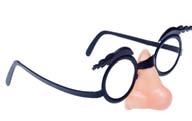
Pathologist Keqiang Ye and his team found that the dye decreases tumor volume in both subcutaneous and intracranial models and extends the life span of brain tumor-inoculated mice. They also found that the dye has potent antitumor effect against human lung cancers.

Ye says that since the acridine family of compounds can damage DNA, more toxicology studies are needed before a new anticancer drug can be developed.—
Quinn Eastman
Some anticancer drugs can block Ebola virus replication

Certain anticancer drugs may be effective against the deadly Ebola virus. An Emory research team has found that the drug nilotinib (Tasigna), approved for the treatment of leukemia, can inhibit the ability of Ebola to replicate in the laboratory.
In previous research they found that nilotinib could be used to fight smallpox and tuberculosis. The drugs shut down human enzymes that some bacteria and viruses exploit. Nilotinib could reduce viral production by infected cells by up to 10,000 fold.

“We had suspected for a long time that many viruses might use the same enzymes at the point where they emerge from an infected cell,” says Daniel Kalmen, an Emory pathologist, who teamed up on the study with Gary Nabel, director of the Vaccine Research Center at the National Institute of Allergy and Infectious Diseases.
One advantage to using drugs that affect such enzymes is that the virus is unlikely to be able to mutate and generate a drugresistant strain, Kalmen says.
Duping cancer cells

While radiation kills cancer cells by inducing DNA damage, some cancer cells evade death by self-repair. Emory researchers have found that if they can sneak RNA molecules into cancer cells, the damaged DNA cannot repair itself.


The method could allow oncologists to enhance the tumor-killing effects of radiation, says Ya Wang, director of Experimental Radiation Oncology at Emory’s Winship Cancer Institute. She and her team used modified lentiviruses to push RNA molecules into cancer cells in the laboratory. Her team is now testing whether a small peptide tag can direct RNA to brain tumors.
Previous RNA interference techniques to silence a gene targeted only the coding region, which makes RNA unstable. Wang’s team targeted both the coding region and the noncoding region, which blocks protein production. This method made brain cancer and lung cancer cells two to three times more sensitive to X-ray radiation.

FALL 2012 3
In Brief
New class of potential drugs inhibits inflammation in brain
Emory researchers have identified a new group of compounds that may protect brain cells from inflammation linked to seizures and neurodegenerative diseases.

The compounds block signals from EP2, one of the four receptors for prostaglandin E2, a hormone connected to fever, childbirth, digestion, and blood pressure regulation. Chemicals that could selectively block EP2 were not previously known. In animals, the EP2 blockers markedly reduced injury to the brain induced after a prolonged seizure, the researchers found.
“EP2 is involved in many disease processes where inflammation is showing up in the nervous system, such as epilepsy, stroke, and neurodegenerative diseases,” says Ray Dingledine, chair of the medical school’s pharmacology department, who headed up the study. “Anywhere that inflammation is playing a role via EP2, this class of compounds could be useful. Outside the brain, EP2 blockers could find uses in other diseases with a prominent inflammatory component, such as cancer and inflammatory bowel disease.”
Making “death receptor” anticancer drugs live up to their name
Cancer cells have an array of built-in self-destruct buttons called death receptors. Several drugs that target death receptors have been developed, but clinical trials have been disappointing so far because cancer cells appear to develop resistance pathways.

Emory researchers are hoping to zero in on tumors that are most vulnerable to drugs that target death receptors. They found that mutations in the cancer-driving genes Ras and B-Raf signify increased vulnerability to drugs that target death receptors.
These mutations occur more often in certain types of cancer. Approximately half of melanoma cancers have B-raf mutations, and K-ras mutations are similarly found in lung cancer. Such mutations are common enough in lung, colon, and pancreatic cancers that they can be useful biomarkers, says oncology researcher ShiYong Sun of Emory’s Winship Cancer Institute.
EMORY MEDICINE 4
Emory residents now can train in Ethiopia


Emory offers its residents a wide variety of places to train, including Grady Hospital, the Atlanta VA Medical Center, Children’s Healthcare of Atlanta, and Emory’s own hospitals and clinics. And now residents can add Ethiopia to that list.


For the past five years, the Department of Medicine has funded rotations in Ethiopia for six third-year internal medicine residents. Now new funding has allowed the medical school to expand the rotation to residents in surgery, radiology, pediatrics, dermatology, anesthesiology, pathology, gynecology and obstetrics, family and preventive medicine, and rehabilitation medicine. Surgical residents will train at Soddo Christian Hospital in Soddo, a city about 248 miles south of Addis Ababa. Everyone else will train at Black Lion Hospital, affiliated with Addis Ababa University (AAU).

James Lee, a former third-year resident who started a cardiac imaging fellowship in August, spent the month of March in Addis Ababa. “It was a unique opportunity to see a medical system that’s different from what we have here,” he says. “While we had some preparation for what we might see, it was very different from what I expected.” He notes that patient care there emphasized the physical exam more than lab work and films.
“About 50% of the cardiac patients I saw were young— in their 20s and 30s—and dying of heart failure due to untreated rheumatic heart disease they had as children,” he says. “Although the facilities there are modernizing, resources are limited, and very few people are able to receive prosthetic valves or heart catheterizations. We had

to do what we could with the medications that were available. We saw many cases that could have had positive outcomes if we had seen them here in the United States.” Lee says that the experience was frustrating at times but extremely rewarding. A highlight for him was teaching third-year AAU medical students how to take a patient history, perform a physical exam, and develop a diagnostic plan.
Former thirdyear resident Lindsay Margoles, who started an infectious disease fellowship at Emory in July, also traveled to Ethiopia in March. “I found that many of the tetanus patients there were in the ICU and had been intubated a long time, something that you wouldn’t

see here in the United States. I also started gathering data for my own study on tuberculosis. During our last week, we provided bedside teaching and led differential diagnosis mini-conferences.”

Surgical residents will be met in Ethiopia by Jonathan Pollock, who joined the Emory faculty in July 2010 after completing his general surgery residency at Emory. He moved to Ethiopia in July 2011 to serve as Soddo Hospital’s assistant program director for its general surgery residency program through the hospital’s affiliation with the Pan African Academy of Christian Surgeons (PAACS). Pollock retains his Emory faculty status.
The chosen residents will be working with African doctors, whom PAACS is training to become general surgeons. In return for their training, the doctors must agree to practice in their home country for five years. Ethiopia has one doctor for every 35,000 people.
FALL 2012 5
Former resident James Lee, now an Emory cardiac imaging fellow, explained to Ethiopian medical students how to take a patient history and develop a diagnostic plan.
In Brief
New compound halts tumor spread in animal studies
Treating invasive brain tumors with a combination of chemotherapy and radiation has improved clinical outcomes, but few patients survive longer than two years after diagnosis. The treatment’s effectiveness is limited by the tumor’s aggressive invasion of healthy brain tissue, which restricts chemotherapy access to the cancer cells and complicates surgical removal of the tumor.
Emory and Georgia Tech researchers have designed a new treatment approach that appears to halt the spread of cancer cells into normal brain tissue in animal models. The researchers treated animals with an invasive tumor with a molecule called imipramine blue, followed by conventional doxorubicin chemotherapy. The tumors ceased their invasion of healthy tissue, and the animals survived longer than animals treated with chemotherapy alone.

Emory dermatologist Jack Arbiser designed the imipramine blue compound, which is an organic triphenylmethane dye. After in vitro experiments showed that the dye effectively inhibited movement of several cancer cell lines, the researchers tested the compound in an animal model with an aggressive cancer similar to a glioblastoma.
Because imipramine blue is hydrophobic and doxorubicin is cytotoxic, the researchers encapsulated each compound in a liposome that ensured that


the drugs would not be released into tissue until they passed through leaky blood vessel walls, which are only present where a tumor is growing.
All of the animals that received the sequential treatment of imipramine blue followed by doxorubicin chemotherapy survived for 200 days with no observable tumor mass. Of the animals treated with doxorubicin chemotherapy alone, 33% were alive after 200 days, with a median survival time of 44 days. Animals that received capsules filled with saline or imipramine blue and no chemotherapy did not survive more than 19 days.
According to the researchers, imipramine blue appears to improve the outcome of brain cancer treatment by altering the regulation of actin, a protein found in all eukaryotic cells. Actin mediates a variety of essential biological functions, including the production of reactive oxygen species. Most cancer cells exhibit overproduction of reactive oxygen species, which are thought to stimulate cancer cells to invade healthy tissue. The dye’s reorganization of the actin cytoskeleton is thought to inhibit production of enzymes that produce reactive oxygen species.

In future studies, the researchers plan to test imipramine blue’s effect on animal models with invasive brain tumors, metastatic tumors, and other types of cancer such as prostate and breast.
Hybrid treatment spares the need for major GI surgery

An Emory team of surgeons and gastroenterologists recently treated patients with tumors of the upper gastrointestinal tract without major surgery, using a minimally invasive approach combining endoscopy and laparoscopy.
The team treated seven pa-

tients who with standard procedures would have needed removal of all or part of the esophagus, stomach, or intestine. The tumors were removed without any open incisions or removal of any major organs. The hybrid technique was successful in five out of seven
cases. The remaining two patients had more extensive GI stromal tumors, and conventional laparoscopic procedures were used to remove the tumors. Follow-up treatment was variable because not all the tumors had the same level of malignancy.
EMORY MEDICINE 6
Drug found to induce cooling decreases brain damage from stroke

Emory scientists are testing a drug that mimics the effects of the hormone neurotensin to lower body temperature and decrease damage to the brain from stroke in mice.
The drug, ABS-201, reduced a mouse’s body temperature by several degrees within 15 minutes. (In contrast, cooling a stroke patient’s body temperature by conventional methods of vests and leg wraps or a cooling catheter takes several hours.) The area of damaged brain tissue in the mice was reduced by 30%.
“Well-controlled hypothermia is a key factor for successful stroke therapy,” says Shan Ping Yu, the O. Wayne Rollins chair in anesthesiology and pain medicine. “The way drug-induced hypothermia works is to lower the ‘set point’ of the temperature-regulating center in the brain. We think this is the first example of applying drug-induced hypothermia to treat ischemic stroke.”
Yu and his team are currently testing ABS201 in animal models of hemorrhagic stroke and traumatic brain injury. Drug-induced hypothermia could be applied to both ischemic stroke and hemorrhagic stroke, he says.
Emory starts neurohospitalist program


Emory’s hospitalist program, first launched in 1998 and now the largest academic hospital medicine program in the country, has helped improve quality of inpatient care. Emory recently launched a neurohospitalist program to focus exclusively on inpatients with neurologic conditions.
“Early data from programs across the country point to decreased length of hospital stays, lower cost of hospitalization, and better outcomes for patients as a result of neurohospitalist care,” says James Greene, director of hospital neurology at Emory.
Emory currently has two neurohospitalists at Emory University Hospital and two at Emory University Hospital Midtown and plans to expand the program to other Emory hospitals.—Kerry Ludlam
FALL 2012 7
Match this! In March Ankoor Shah and Diogo Anyigbo celebrated his match in pediatrics to Childrens National Medical Center in D.C.
In Brief
Keeping the care team on the same page
When Jason Stein 98M was a medical student, he considered himself lucky if he was able to visit his patients with their assigned nurse present. Very few times did their schedules ever sync so that they could do patient rounds together. Today, as a hospital medicine physician with Emory University Hospital (EUH), Stein has helped change the way care teams work together on medicalsurgical units.
More than a year ago Stein was part of an Emory Healthcare committee charged with finding ways to improve patient care quality and communication between the health care team and patient. What the committee came up with has developed into structured interdisciplinary bedside rounds, or SIBR
Every day, the unit’s bedside physicians, residents, nurses, social worker, and pharmacist go from room to room to discuss each patient’s progress with the patient and the patient’s family. This way, everyone on the care team and the patient and family hear the same report and can update the care plan together.
“SIBR-ing” on each unit, with 12 to 15 patients, lasts about an hour each day. Physicians have been coached to sit at eye level with the patient and not to use jargon. “The physician talks with the patient, and the rest of the care team listens in,” Stein says. “We’re not talking about every medication and dosage. We address the patient and family’s concerns and cross-check each other
on the patient’s progress. We’re talking about the discharge plan every day.” The care team also goes over a quality-safety checklist.
“Patients expect hospital professionals to coordinate with each other,” Stein says. “Yet we have come to accept the practice of asynchronous care— hospital professionals filtering in and
antiquated patient admittance system, Stein says. Doctors usually have patients on multiple floors and cannot predict where and when they will reach a specific room. For EUH’s SIBR units, patients who are admitted become the responsibility of a physician assigned to the unit. Physicians assigned to a SIBR unit are dedicated almost entirely to patients on that unit.
Every day, the unit’s bedside physicians, residents, nurses, social worker, and pharmacist go from room to room to discuss each patient’s progress with the patient and the patient’s family. This way, everyone on the care team and the patient and family hear the same report and can update the care plan together.
out of a patient’s room at unpredictable times and without a shared model for how and what to communicate.”
Many hospital teams’ fractured communication is a product of an
Stein says he’s a happier doctor—he practices on one unit and knows each care team member who works in the unit, something that was difficult when he was constantly traveling between units. He estimates that he receives 60% fewer pages every day simply because he is always on the unit and accessible. Results also have been positive for patients. SIBR at EUH has been associated with a nearly 50% reduction in in-hospital mortality its first 12 months of implementation compared with the preceding 12 months. Patient length-of-stay has gone from an average of 5 to 4.5 days. Nursing turnover has gone from approximately one nurse per quarter to zero. Patients have commented that their care teams seem coordinated, and some incoming patients have even requested to stay on a SIBR unit, Stein says.
SIBR also has been implemented at Emory John’s Creek Hospital. Stein recently traveled to Melbourne, Australia, to support the rollout of SIBR at several area hospitals, and closer to home, the Center for Medicare & Medicaid Innovation is evaluating the SIBR model and its outcomes.
EMORY MEDICINE 8
Emory resident gets behind-thescenes media exposure

When ABC News sent an email asking for medical school residents to serve as interns at ABC’s headquarters in New York, Emory emergency medicine resident Murtaza Akhter was not shy about coming forward.
“When I found out about this opportunity, I thought it would be interesting to see the inner workings of a news organization,” says the Chicago native. A second-year resident, Akhter studied economics at the University of Chicago and then transitioned into medical school after working at the Law and Economics Consulting Group.
Akhter spent the month of May researching story ideas, recruiting comments from experts for medical producers and writers at ABC, and writing medical stories for ABC.com. He became the preferred researcher of medical editor Richard Besser and was even asked if he would consider staying on full-time.
Hundreds of residents from across the country applied to ABC, and another Emory emergency medicine resident, Amit Pandit, was chosen for 2013.
$5 million gift to fund pediatric faculty
The Marcus Foundation, chaired by Home Depot co-founder Bernie Marcus, has donated $5 million to the Department of Pediatrics to create the Marcus Society in Pediatrics. The society is comprised of 15 Marcus Professors in Pediatrics—six existing ones and nine who are newly funded—and an annual visiting scholar. The 15 Marcus professorships represent the greatest concentration of distinguished academic positions funded by a single donor in any one area at Emory.
Emory to help improve critical care in north Georgia communities
Emory received a $10.7 million award from the Centers for Medicare and Medicaid Services for its plan to build a telemedicine network supporting ICUs in North Georgia. By combining training for nurse practitioners and physician assistants with telemedicine intensive care services, the collaborative will improve critical care for patients in rural and underserved areas.
Funding to Emory and 25 other awardees across the country was made possible by the Affordable Care Act and will support projects that expect to save money, improve quality of care, and enhance the health care workforce. The awardees expect to reduce health spending by $254 million over the next three years.
Emory Healthcare will partner with Saint Joseph’s Health System, Northeast Georgia Health System, Southern Regional Medical Center, and telemedicine provider Philips Healthcare to train nurse practitioners and physician assistants at Emory for six months and to integrate telemedicine ICU services into community hospitals to allow remote support by experienced critical care doctors and nurses. The program is expected to save more than $18 million over three years.
FALL 2012 9
ABC News’ medical editor Richard Besser and Emory resident Murtaza Akhter review a story.
By Martha Nolan McKenzie
MOVING THE HIV VACCINE FORWARD
EMORY MEDICINE 10 DNA MVA GM-CSF
In 1953, Jonas Salk announced that he had successfully tested the world’s first vaccine for polio. Just the year before, there were 58,000 new cases of polio in the United States alone. Today polio barely warrants attention, thanks to its vaccine. Emory researchers would like to do the same for the human immunodeficiency virus (HIV).
There is no known cure for HIV, but what if you could give a vaccine to protect your patients against HIV, just as you do for mumps or polio? Microbiologist and immunologist Harriet Robinson says that contrary to public perception, real progress is being made toward an HIV vaccine. Robinson, a former professor at Emory, now is full-time at GeoVax,

FALL 2012 11 MVP
More than 1.8 million children took part in Jonas Salk’s trial to test his polio vaccine.
a company she co-founded to commercialize the vaccine developed in her laboratory at Emory, the NIH, and the CDC. GeoVax’s first-generation vaccine controlled HIV should a person become infected, but the second generation, which started human trials in May, goes a step further.
“The first generation of our vaccine was primarily controlling infection,” says Robinson. “If an animal was vaccinated and then exposed to SIV (simian immunodeficiency virus,
GeoVax to handle vaccine manufacturing, regulatory filings, and commercialization while Amara continued to oversee the preclinical phase of the vaccine development.
The original vaccine regimen consisted of two inoculations of DNA that contain noninfectious HIV particles to prime the immune response, followed by two inoculations of MVA, an attenuated smallpox vaccine. “DNA is relatively inefficient in entering cells, so we use it to get the immune
the nonhuman primate version of HIV), the vaccine kept the infection to low levels, but it didn’t actually prevent infections. With this new vaccine, we are preventing infection in animal models. That is what is exciting.”
Robinson began working on HIV vaccines in 1992. She was one of the discoverers of DNA vaccines and had been working with a chicken retrovirus as the AIDS epidemic spread. “It was just logical to take this new method of vaccinations and begin to develop it for HIV,” says Robinson.
Emory microbiologist and immunologist Rama Rao Amara joined her lab in 1999 and conducted much of the original nonhuman primate research. Meanwhile, Robinson formed

response primed,” says Robinson. “MVA gets into cells more efficiently and produces more protein, so we boost the response with MVA, into which we have tucked HIV genes.
The new vaccine, developed with Amara, keeps the DNA and MVA components but adds the adjuvant GM-CSF (granulocyte-macrophage colony-stimulating factor) in the HIV proteins in the DNA. “GM-CSF is a normal protein that improves immune responses,” says Robinson. “It’s already being used in a prostate cancer vaccine, and it’s also used to stimulate the production of white blood cells in chemotherapy, so it has a good safety record in humans.”
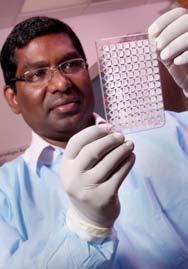
In the preclinical trials of the GM-CSF vaccine, monkeys were given two DNA inoculations at months 0 and 2 to prime the vaccine response and then two booster MVA inoculations at months 4 and 6. Six months after the last vaccination, both vaccinated and unvaccinated animals were exposed to SIV once a week for 12 weeks.
The level of virus to which they were exposed, however, was much more potent than would naturally occur. “In humans, the transmission of HIV is very poor,” says Amara. “Only one out of 100 to 500 exposures results in infection. We can’t work with such low rates in the lab and get any meaningful results, so we use much higher doses of the virus.”
After 12 exposures to SIV, 25% of the animals vaccinated with the original vaccine were protected. However an impressive 70% of the monkeys given the GM-CSF vaccine remained infection free; that translates into a per-exposure vaccine efficacy of 90%. In this and subsequent trials, all of the unvaccinated monkeys became infected.
“Repeated exposures in animals are used to mimic sexual transmission,” says Robinson. “The hope is that the
EMORY MEDICINE 12
Harriet Robinson is testing a vaccine with an added protein that stimulates immune responses. Rama Amara conducted much of the nonhuman primate research for the vaccine.
results in the nonhuman primate models will translate into vaccine-induced prevention in humans.”
The animals that were not infected received a booster MVA dose a year later. Six
months later they were exposed to another series of 12 weekly virus challenges. This time four of the five monkeys given the GM-CSF vaccine were protected, and, again, all of the unvaccinated animals were infected.
“No one doing this type of study has ever had enough protected animals to go through a second series of challenges,” says Robinson. “These results are very good. The second trial translated into a per-exposure vaccine efficacy rate of 94%.”
A third series of exposures was undertaken six months later with a highly neutralization-resistant form of SIV In this trial, all of the monkeys became infected but not right away. One was infected at the third challenge, one at the 10th, another at the 11th, and the last one at the 12th. “The vaccine was able to significantly delay infection, even against this strain,” says Amara. “That is very promising, especially considering the high doses of the virus we are using.”
Robinson credits three factors for the vaccine’s success. “Of the researchers working on HIV vaccines, we are among the few who designed a vaccine to make a noninfectious virus-like particle—others use mixtures of individual proteins,” she says. “We are the only ones who express the full length of the virus envelope. The envelope is the part of the virus that is on the surface that binds to the receptors on T cells. It’s what gets the virus into cells, so it is the target for antibodies that can block infections. Other researchers are expressing subunits of the envelope, but we try to mimic the entire form that is on the virus.
“And finally, we are the only ones who are coexpressing GM-CSF in the vaccine,” Robinson says. “Others have tried using GM-CSF as an added protein, but we tucked it right into the DNA, so it is expressed off the same DNA that expresses noninfectious virus particles. It’s exactly where it needs to be.”
Spurred by the promising results in nonhuman primates, clinicians have begun testing the DNA/ MVA GM-CSF vaccine in a phase 1 human trial through the HIV Vaccine Trial Network. “We will do a dose escalation, and if this is safe and we show the anticipated immune response, we hope to go directly to a phase 2a/2b trial, which would be a 4,000-person efficacy trial,” says Robinson.
While the phase 1 trial is limited to a low-risk population, the phase 2 trial would target a high-risk group. “Phase 2 will test men who have sex with men in the Americas,” says Robinson. “We will give half a placebo and half the vaccine and follow them for 1½ years. This will test if the vaccine actually prevents infection in humans.”
Robinson also has an ongoing therapeutic trial that tests the vaccine on people already infected with HIV to see if it can control the virus in the absence of drugs.
The impact an effective HIV vaccine could have is hard to overstate. “The United States has a staggering 55,000 new HIV infections each year—that’s as many people as died in the Vietnam War,” says Robinson. “But only about 35% of those infected have infections that are well controlled by drugs. So the need just in the United States is tremendous, and when you consider the rest of the world, it’s incalculable.
“I don’t think I appreciated how far we had to go when we started our campaign to make an AIDS vaccine,” she says. “I can remember the then-director of Yerkes saying to me in 1998 that, ‘We were launched.’ But in actuality we were just starting. Now, 14 years later, people are amazed at how far we have gotten. Right now we are in one of the hardest phases to fund—beyond basic research that can be funded by NIH grants and before the results of efficacy trials. But we have a solid base, and the trick now is to swing for the next highest bar.” EM
FALL 2012 13 DNA MVA GM-CSF

THE BUILDER: How Tom Lawley crafted a national presence for Emory’s medical school





 by Sylvia Wrobel
by Sylvia Wrobel
Tom Lawley is stepping down this fall after a 16-year run as dean of the medical school. Along the way he crafted a national presence for a once regional school. His legacy includes a five-fold rise in research funding; a new curriculum; a doubling of faculty size; six new departments; more than 1 million square feet of new clinical, teaching, and research space; and an uncommon spirit of collegiality. At Emory, chairs actually like each other.
FALL 2012 15
Before becoming dean, Tom Lawley had already shown his talents as chair of dermatology for eight years. When he arrived on the scene in 1988, the department was in bad straits. There were only three faculty, and research funding had tanked. It had nowhere to go but up. Lawley smoothly guided its rise. By the time he left the chairmanship, the department had grown into the country’s third highest in National Institutes of Health funding and employed 18 faculty.

pedigree, was a respected clinician, had proven his ability to attract and retain faculty who liked and trusted him, and bested a series of top-notch national candidates who auditioned for the role.
134final II-Lawley-5-05JK-g...
Looking back, Johns, who just retired as Emory’s chancellor, says Lawley’s ability to develop strong, trusting professional relationships and his integrity—the first word colleagues use to describe him—proved indispensable in the years ahead, as did his fabled calm temperament. In a time of change, when he was about to launch a blueprint for research, or even more so in time of turmoil, as the school would face with changes in its clinical practice and the neardemise of Grady Memorial Hospital, Lawley maintained his


The dean of the medical school had noticed. He told Lawley that a successful chair sooner or later would want to become a dean, so why not work alongside him for a while to learn the game from the inside? Lawley laughed. “Why would I want to do that? You have the worst job in the world.” But ever loyal, he took on additional responsibilities as executive associate dean and then, after the dean left for another school, as interim dean.
“At that time, the medical school was a sleeping giant,” Lawley says. “It was just beginning to wake up to how good it could be, to realize it had the potential and the resources to become a national leader.”

Michael Johns, then the new executive vice president for health affairs, believed Lawley was the man who could take the school there. Lawley had a strong NIH research
quiet confidence, conveying his belief that steady, sustained effort would pull the school through any problem.
Embracing the unknown
As a kid, Lawley’s ambition was to play second base in the major leagues. Then he became fascinated by the grace and skill with which a teammate’s physician father tended to players’ lacerations and other injuries. By the time he was a medical student at SUNY-Buffalo, Lawley had his life all planned out. He would marry his college sweetheart, Christine, finish his residency at Yale, and set up a general dermatology practice in his hometown of Buffalo. Being a doctor already seemed a giant leap for the son of a detective and social services caseworker, the first generation in his family to go to college. In medical school, Lawley had
EMORY MEDICINE 16
MM51201-08JK218-Lawley...
Lawley_Bulldozer_9-22-05J...
1 4 3 2
MM51301-05JK123-Lawley...
been so unworldly that he initially declined an invitation to join Alpha Omega Alpha, assuming it was a social fraternity for which he had no time.

“If someone had told me I would become a researcher, I would have said they were crazy,” he says. “I did research as a medical student, and I didn’t like it.” During his residency, first at Yale, as planned, then back at Buffalo, where he returned after his father’s unexpected death, he saw a disconnect when he looked at many of the faculty who were “nice, normal people inexplicably dedicated to research.” Yet when SUNY-Buffalo allowed Lawley to complete the last year of his residency in the dermatology branch at the National Cancer Institute (NCI), he discov-
colleagues Wright Caughman, now Emory’s executive vice president for health affairs, and Robert Swerlick, now chair of dermatology and chief of dermatology services for Emory Healthcare.
Finding triumph in a ‘worst job’

The best part of being dean, says Lawley, was recruiting chairs who shared his belief in the school and in doing the right thing for the school, however painful for the individual or department. Claudia Adkison, former executive associate dean, says that more than once she watched Lawley pass over a chair candidate widely assumed to be the No. 1 catch in the country because he
ered he was wild about research, when the questions were his own. Over the next 13 years, he developed a national reputation as a researcher in immunologically mediated skin disease. He also treated patients, a practice he continued throughout his career at Emory.
When he took the Emory dermatology chair, his NCI colleagues were dubious. They saw a quagmire, but Lawley saw an opportunity to build a program from scratch. The Emory chairs of medicine, pathology, radiology, and surgery were so eager for him to come that they offered him some of their own funding and research space. The ink on his contract had barely dried when Lawley began recruiting, starting with NCI

“At that time, the medical school was a sleeping giant,” Lawley says. “It was just beginning to wake up to how good it could be, to realize it had the potential and the resources to become a national leader.”
felt the person lacked the collegial character he wanted among his leadership. For much of its history, the medical school had focused mainly on patient care and teaching. Research had taken a backseat. When Lawley took over, that had begun to change. The school won research funding faster than more established medical schools, although, Lawley admits, it was starting nearer the bottom. To make up for lost time, it needed a critical mass of researchers and research space. Lawley launched the school’s first research strategic plan in a decade. Six years later, the school had 80% more investigators, half a million gross square feet of new
FALL 2012 17
1. In the dermatology lab where he studied microvascular endothelial cells
2. With Jack Shulman, former executive associate dean for medical educaiton, and Claudia Adkison, former executive associate dean
3. Medical students cut the ribbon to open the new medical education building in 2007.
4. With then Woodruff Health Sciences Center CEO Mike Johns at the medical education building’s topping out ceremony
5. Demolition day of the old building
6 5
6. Throwing out the first pitch at a Braves game in 1998
research space, and new programs and services to support research.
During Lawley’s deanship, the school began the largest construction boom since the university moved from Oxford, Georgia, to Atlanta in 1915. One million square feet of new space was added. Research funding shot up five times over, to more than $427 million last year. The school now ranks 15th in NIH funding.
Lawley seized an opportunity few deans get: to oversee the design of a new building and new curriculum simultaneously. The 162,000-square-foot James B. Williams Medical Education Building, which opened in 2007, quadrupled teaching space and made possible a 15% increase in class size.
graduate “on time,” much to the faculty’s delight, having opted to complete an MPH or pursue additional research.
Road bumps
Not everything about being dean was fun though. Inevitable problems arose: a student or faculty member who crossed an ethical line, faculty or staff disagreements with some decision or direction. But, “Tom balances competing interests with dignity and respect, even when personalities are strong and the noise level rises,” says Ray Dingledine, executive associate dean for research.
Noise was particularly high during the restructuring of The Emory Clinic in the mid-1990s, from a private, for-
The new curriculum, which also debuted in 2007, exposes students to patients early and often from their first semester; teaches basic science in the context of its relevance to health and disease; provides more time in small group classes and outpatient settings, where most doctorpatient interactions occur; and includes a minimum five months of “discovery” at Emory, CDC, NIH, or other research settings and a mentoring system in which faculty and students remain in the same small group together from year 1 through graduation.

Overall, students give positive feedback on the new curriculum. They are hitting new levels of residency matches, and some are graduating with first-author publications, says Bill Eley, executive associate dean for medical education. Last year almost a fifth of the class did not
profit partnership to a nonprofit faculty practice, a time filled with overflowing meetings, strongly held opinions, and considerable angst.
Johns, who oversaw the restructuring, credits Lawley with infusing the process with a calm confidence, gaining support of the chairs and section heads. “If someone brings Tom a problem, they leave his office understanding his position and respecting how he arrived at it,“ he says. They also know, adds Eley, that “they always have access to him, that what is said behind closed doors stays there, and that once he promises something, it comes to pass if humanly possible.” Adkison says she watched Lawley fight battles for chairs and faculty that they had no idea were even going on.
The crisis that cost Lawley the most sleep revolved

EMORY MEDICINE 18
2 1
around Grady, the large public hospital where about onefourth of Emory medical school faculty, 360 residents, and many medical students spend part or all of their time. Over the years, Lawley watched in dismay as his faculty at Grady struggled with aging equipment, lack of basic supplies, and administrative disorder. Grady’s multimillion-dollar deficit climbed, and state and county support shrank. Vendors waited months for payment, and Emory was always last in line. Ten times Lawley entered discussions with the hospital CEO, only to begin again when that CEO was replaced. Had Emory called in the debt, he says, the hospital would have gone under.
What Lawley, Bill Casarella (executive associate dean

Grady, fueling enthusiasm from other donors, and Emory forgave part of the $60-plus million Grady owed the school. The following year, Grady’s finances began to improve.

Second life
“The medical school is in a good place now,” says Lawley, “and there are other things I want to do professionally and personally.” He plans to take a year’s sabbatical and travel with Chris to New Zealand and Africa and back to Ireland, a favorite destination of theirs. He will read some of those books Chris keeps recommending. He and several other health sciences center administrators took up quail hunting, and he found he liked it. His hunting dog has died, but his
4. (l to r) The Lawleys’ son Tom works in development at Georgia Tech; his wife, Lesley, is an Emory pediatric dermatologist; Lawley and his wife, Chris; daughter Meg, who is now an Emory ob/gyn resident, and her husband, David Goldsmith, who is now an Emory psychiatry resident. Another son, John (not shown), works in Emory’s research compliance department.
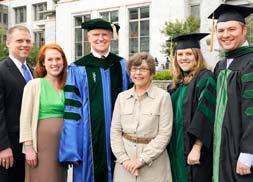
for clinical affairs at Grady), and the faculty did was sound the alarm, starting with elected officials and others. Former Georgia Pacific Chair Pete Correll first saw Grady’s dire condition on an ER tour arranged by the medical school. Shocked, he started mobilizing. The Atlanta Chamber of Commerce created a task force of 17 business leaders, chaired by Correll and real estate developer Michael Russell. Its rescue plan included a new governance structure. Named to the new Grady Health System Board, Lawley provided a better understanding of Grady’s importance—and Emory’s contributions to the hospital. In the end, the Woodruff Foundation pledged $200 million to the effort to rebuild
shotguns are at the ready. He enjoys making pasta, risotto, and other dishes he calls “experiments” on the weekends and hopes to take cooking lessons in Italy.
During Lawley’s deanship, the school began the largest construction boom since the university moved from Oxford, Georgia, to Atlanta in 1915. One million square feet of new space was added. Research funding shot up five times over.
And, to no one’s surprise, he will work. As a faculty member, he’ll spend more time with patients, teach more, write about issues like student debt and health care reform. Speaking at his last graduation ceremony as dean this past May, he urged students to recognize and be open to the opportunities that will present themselves throughout their careers. “If I had not done that,” he said, “I would have missed so much. I started by wanting nothing more than to help make patients healthier. I ended up finding new ways to do it.” EM
FALL 2012 19
1. In 1997, the Emory-Children’s Center opened. Lawley postponed his own medical education building in favor of the pediatric building. Faculty had been working in WWII-era trailers.
2. With Emory President James Wagner (l.) and former Suntrust Bank CEO Jimmy Williams, for whom the medical education building is named.
3. Playing baseball at the NIH
5 4 3
5. With wife Chris in 1996.



A scientist comfortable with running a laboratory may still fi nd the worlds of corporate fi nance and venture capital daunting.
The ar t of the s ell
By Quinn Eastman • Illustrations by Richard Allen
A
Are you smart enough to know that you don’t know everything?
If you want to take a product to market that you have spent years developing, you better check your ego at the door, says one venture capitalist who recently helped coach Emory medical school faculty.
“Venture capitalists want to know whether you are coachable,” says Donovan Moxey. “You should be smart enough to know that you don’t know everything.”
Moxey, who founded LIPSinc, a 3D animation software company in North Carolina, knew that he didn’t know much back in 1998 when he was developing his software. He turned to FastTrac Tech, a course offered by the Council for Entrepreneurial Development (CED) to stimulate high-tech companies in the Greater Research Triangle area. Moxey completed the course in August of that year, and by October he had raised $500,000. By February 1999, he had closed in on $1.3 million in first-round funding.
FALL 2012 21
Today he sits on the board of CED and shares his experiences with other budding entrepreneurs, like the 22 from Emory, Georgia Tech, and the University of Georgia who were taking the course this past spring on the Emory campus. The six-week FastTrac was sponsored by Emory’s Office of Technology Transfer, which helps shepherd faculty inventions from the lab bench to the hands of a commercial partner. In addition to Moxey, the group also heard from four other CEOs, three COOs, an executive recruiter, a patent attorney, and a venture capitalist.
“Several Emory faculty members have had success starting their own companies, and one of the goals of the program is to help make that group larger,” says Todd Sherer, director of the Office of Technology Transfer. “Another is to let
aspiring entrepreneurs know more about how start-ups work. We want them to be prepared for the process of working with business leaders and investors.”
Many doctors and scientists have great ideas, Sherer says, but they still need investors, patent protection, and eventually the ability to pay employees. A scientist who is comfortable running a laboratory or preparing a grant application may still find the worlds of corporate finance and venture capital daunting.

And finding funding in today’s depressed economy can be especially trying.
Challenging times
Currently, inventors face a shrunken venture capital sector and a relative lack of high-tech business know-how in the Atlanta metro area. In addition, to pass muster with the FDA, companies that are developing new drugs will have to withstand the testing of clinical trials, which are becoming more expensive.
Stephen Snowdy, principal of Ansley Ventures, explained to course attendees that venture capital firms like his were pulling back, especially in the biotechnology and medical device areas. Firms typically are interested only in investing in a start-up that has already grown to a substantial size. Ironically, this means that entrepreneurs need to start earlier than ever in their search for potential investors.
“You cannot wait for us to come to you,” Snowdy said. “The earlier you can make connections, the easier it’s going to be to make your pitch.”
And keep it short and simple, Moxey emphasized. If an entrepreneur can’t make an “elevator pitch” in a few minutes, he or she won’t be convincing, Moxey says.
Both Snowdy and Moxey urged par-
ticipants to look outside Atlanta for business contacts. There are fewer than five venture capital firms in Atlanta that support the life sciences, says Kevin Lei, director of faculty and start-up services for Emory’s Office of Technology Transfer. In fact, a 2009 Georgia Tech study found that 40% of Atlanta’s high-tech start-up companies leave for other states within three years. Lei says the short supply of start-up CEOs and other key employees and the lack of a physical focal point for coordinating research and development are two big reasons why Atlanta has trouble competing with North Carolina’s Research Triangle Park.
Taking the plunge
For a scientist, it’s not always necessary to start a business to see an idea from the lab to a product. Emory’s tech transfer office can license the technology to an outside business, letting the scientist take a passive approach. But to drive the process and shape the final result, active participation is key.
Cardiologist Young-sup Yoon says he had filed the papers for his business a week before the last session of the class. Based on his laboratory’s research, his company AlphaStem hopes to develop bone marrow cell therapy as a treatment for peripheral artery disease. He has already recruited experts in the field at Emory, such as cardiologist Arshed Quyyumi and hematologist Edmund Waller, and others from Boston and Frankfurt to serve as scientific advisers. Similarly, immunology researcher and engineer Rabindra Tirouvanziam says he had received a go-ahead to start a business from his department chair a day before the last session. He plans to refine technology he developed while at Stanford that would allow doctors to test more easily for peanut allergies.
EMORY MEDICINE 22
“It’s much too complicated to get a simple answer to the questions: are you allergic to peanuts, or have you outgrown your allergy,” he says. “The most definitive tests are expensive and timeconsuming. The blood-based tests available now are not predictive enough. Big companies are spending a lot on marketing products that allergy specialists don’t like.”
Tirouvanziam’s technology can measure the reactivity of basophils, the cells in the blood that trigger allergic reactions. He described a scheme where a patient’s blood sample would be sent to a central laboratory and then data would be posted on a secure Internet site.
“I think we can learn a lot from how NetFlix handles distribution,” he says.

Other class participants had already traveled partway down the start-up journey. Genetics researcher Peng Jin founded Effigene Pharmaceuticals in 2007. Effigene sells tools for enhancing RNA interference, a gene-silencing technique that is used frequently in the laboratory and has the potential for several clinical applications.
As a start-up, Effigene was able to recruit board members and secure a grant from the federal program Small Business Innovation Research, but Jin says he is looking for insight on how to take the company further. The compounds he identified can shut down cancer cell growth, so he is looking to shift the company’s focus to emphasize cancer applications.
“I have found the discussion of financial issues very useful,” Jin says. “For people trained in the life sciences, this type of thing doesn’t come naturally.”

Well-defined market
Nephrology researcher Jennifer Gooch formed her company, ImmunoMetrix, to commercialize a test that could help doctors gauge whether a transplant recipient’s immune system is under control. The test measures the effectiveness of tacrolimus, a drug most transplant recipients must take to prevent graft rejection.

“Doctors can see how much tacrolimus is in the blood but not whether it’s having the desired effect on the immune system,” she says. “That means they’re still sort of flying in the dark.”

Her product has a well-defined target market: transplant recipients must take a test every week immediately after their transplant for a period of time and then every month thereafter. For all transplant patients in this country combined, that’s 1.75 million tests per year, at $200 per test, she says. Tacrolimus is also prescribed to people with autoimmune diseases, a larger potential market.
Gooch says the class helped her make connections with peers who had faced similar situations.
“It’s been helpful to find a community and to talk to people who have already navigated the same obstacles,” she says.
Postdoctoral fellow Cassandra Quave had a personal angle to her presentation. At the age of three, she needed to have her leg amputated because of a life-threatening bacterial infection. Years later, her experience has powered her research into drugs that can disrupt the antibiotic-resistant biofilms formed by staph bacteria.
“At the beginning, I wasn’t sure whether I should include something personal in my business presentation,” she says. “But people told me that it really helped them understand where I was coming from.”
An ethnobotanist, Quave discovered that an extract from plants she studied contained compounds that disperse biofilms. She started her company PhytoTEK while she was a postdoc at the University of Arkansas and teamed up with Sahil Patel, a colleague at Harvard, to win a top-three spot in a 2011 Harvard business plan competition.
She and Patel are proposing to first sell their anti-biofilm agent to pet owners or farmers for use in animals. They envision that the profits could fuel the studies needed before PhytoTEK’s extract can be approved for use in humans.
Emory currently manages more than 1,000 technologies invented by its scientists and physicians, and more than 50 new products have been introduced to the marketplace by Emory scientists. Quave, like other budding entrepreneurs at the FastTrac class, hopes to be one of those success stories. EM
FALL 2012 23
Class Notes
1970s
Michael Born 67C 71M 75MR, of Ponte Vedra Beach, Fla., retired May 1 from his gynecology practice at the Mayo Clinic in Jacksonville, Fla. He also served as chair of the department for six years.
John Fountain 73Ox 75C 79M 83MR was elected to the Conyers (Ga.) City Council.
1990s
Jada Bussey-Jones 88C 92M was selected as a member of the 2013 class of Leadership Atlanta. She is co-director of the Primary Care Center at Grady Hospital.

Stephen Bonasera 95G 95M was named the 2012 recipient of the Joseph Gilmore Distinguished New Investigator Award at the University of Nebraska Medical Center.
2000s
Jeffrey Brewster 00M was elected to the board of directors of the American College of Pediatricians. He is a pediatric intermediate care specialist in Columbus, Ga.
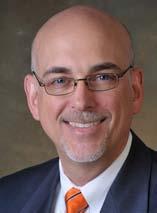
MARRIED: Janet Whitte 01M 02PH to John Hopkins in February 2012. She works in depression research at Massachusetts General Hospital and has a private practice.

MARRIED: Daniel Sims
03M 07MR to Katherine Small on May 25, 2012, in New York. He is an assistant professor of cardiology at Emory. She began a fellowship in gastroenterology in July at Emory.
MARRIED: Kate Koplan
04M 04PH to Gregory Little on May 5, 2012, in Key West, Fla. She is director of medical management at Atrius Health, a nonprofit alliance
Keeping it in the family
Austin Zorn 12M received his medical degree in May and was joined by father Donald 72C 76M and uncle George 62Ox 64C 68M. George is a retired cardiothoracic surgeon in Birmingham, Ala. Donald is the director of the Tallahassee Memorial Family Medicine Residency Program in Florida, and Austin is following in (and behind) his dad’s footsteps.
Austin started his residency, alongside his father, this past summer. Donald and George’s other brother, Richard 69C 73M 78MR, is a general surgeon in Tallahassee. The Zorn family supports scholarships for Emory medical and nursing students.

alumni news
EMORY MEDICINE 24
Jeffrey Brewster 00M
Jada Bussey-Jones 88C 92M
Bradley Morganstern 08M to Jennifer Raznick 02C
Donald, Austin, and George Zorn
of six group practices in eastern Massachusetts. She also practices internal medicine at one of those practices, Harvard Vanguard Medical Associates in Boston.
MARRIED: Andrew Stec 04M to Stacy Carfi on April 21, 2012, in Key Largo, Fla. He is assistant professor of urology and pediatrics at the Medical University of South Carolina in Charleston.
BORN: Lena Shah on Feb. 27, 2012, to Bijal Shah 96B 06M and her husband, Doug Shipman.
MARRIED: Bradley
Morganstern 08M to Jennifer Raznick 02C on Oct. 22, 2011, in Great Neck, N.Y. He is a gastroenterology fellow at Stony Brook University Medical Center.
Residency Notes
Valeri Akopov (internal medicine) was named vice president and chief of hospitalists at WellStar hospitals in metro Atlanta. He was most recently director of hospital medicine services for Emory University Hospital Midtown, where he helped establish a hospitalist program.
Michelle Baron (internal medicine) was
appointed vice president of clinical research and chief medical officer of Intarcia Therapeutics. She previously served as vice president of the U.S. diabetes division at Sanofi-Aventis.
John Draper (orthopaedics) was elected to the board of directors of West Virginia University Hospital-East.
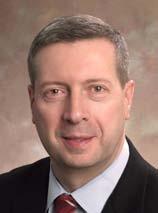
Ximena Zornosa (oral and maxillofacial pathology) received the 2012 Alice Smith Award from Clayton State University. She is an associate professor in the department of dental hygiene.
Deaths 1940s
John Malone 44M, of Green Cove Springs, Fla., on May 2, 2012. He was in private practice in Green Cove Springs from 1946 to 1977 and then served as executive medical director of the Clay County Public Health Unit until his retirement in 1990. He was preceded in death by his wife, Angelyn, and is survived by two children, a grandchild, and two greatgrandchildren.
William Moncrief Jr. 44M, of Fort Belvoir, Va., on April 10, 2012. He served
31 years in the Army as a general and cardiothoracic surgeon and retired a major general in 1973. During the late 1960s, he oversaw the civilian health program in Vietnam for USAID and was an adviser to the Vietnam ministry of health. He entered private practice in San Francisco in 1973 until 1995, when he retired to Colorado. He is survived by four children and six grandchildren.

Dale Allen 44C 46M, of White Pine, Tenn., on Feb. 4, 2012. He is survived by his wife, Carmen, three children, six grandchildren, and two great-grandchildren.
Leslie Buchanan 42C 46M 49MR, of Atlanta, on Feb. 29, 2012. He served as a clinical assistant professor of surgery for nine years at Grady Hospital. He served as DeKalb Medical Center’s first chief of staff and later, as chief of surgery. He was a member of the DeKalb
Hospital Authority for 17 years and was a founder of the Hospice of the Good Shephard, an all-volunteer group. He is survived by his wife, Mary, four children, and five grandchildren.
O. Grey Rawls 44C 46M, of Albany, Ga., on Jan. 28, 2012. He was a surgeon and board member of Phoebe Putney Hospital in Albany. He was preceded in death by his wife, Betty, and is survived by three daughters and four granddaughters.
Leon Graybill 42C 48M, of San Rafael, Calif., on March 21, 2012, of heart failure. He joined the U.S. Army medical corps in 1948 and served in Tokyo, Frankfurt, West Point, and San Francisco. He retired from the Army after 21 years and then served as chief of radiology at Kaiser Permanente Hayward Medical Center in Hayward, Calif., until 1984. He is survived by his wife, Florence, three children,
FALL 2012 25
John Malone 44M
Valeri Akopov
two grandchildren, and two great-granddaughters.
1950s
William Wager 45C

51M, of Monroeville, Ala., on Feb. 26, 2012. He was 88. He was a general practitioner in Port St. Joe, Fla., before completing a radiology residency at the University of Tennessee. He was preceded in death by his wife, Dolly, and is survived by three children, eight grandchildren, and a great-grandson.
Richard George 50C 53M
53MR, of Prescott, Ariz., on March 7, 2011, of heart disease and Parkinson’s. He is survived by his wife, MaryAnn, six children, and 13 grandchildren.
Jean Staton 48G 53M
56FM, of Avondale Estates, Ga., on May 6, 2012. She was 86. She earned a master’s degree in neuroanatomy

before becoming one of two women in her medical class. She practiced internal medicine in Decatur, Ga., from 1957 until 1991 and served as Coretta Scott King’s personal physician. After she retired, she served as chief of medicine at Wesley Woods Geriatric Hospital and medical director of the volunteer Physicians’ Care Clinic. She received the 2004 Julius McCurdy Citizenship Award in recognition of her community service in DeKalb County and the 2005 Medical Association of Georgia’s Distinguished Service Award. She is survived by a son and granddaughter.
Edwin Pound 50C 54M, of Atlanta, on Feb. 24, 2012. He completed a surgical residency and taught pathology at Veteran’s Hospital in Durham, N.C., before entering the relatively new field of plastic surgery. After
training in plastic surgery at Duke University and in hand surgery in Detroit, he returned to Atlanta to open a practice in 1961, one of just a handful of plastic surgeons in the Southeast. He helped establish the Trans-Umbilical Breast Augmentation procedure. He is survived by his wife, Kathleen, two daughters, and five grandchildren.
Stanley Gould 55M 58MR, of Simpsonville, S.C., on March 3, 2012. He is survived by his wife, Bobbie, three children, and four grandchildren.

1960s
Peter Temple 63M, of Tarboro, N.C., on March 8, 2012. He was 74. He practiced family medicine for 30 years and retired in 1998. In keeping with his support for the establishment of a medical school in eastern North Carolina, he donated his
body to the Brody School of Medicine at East Carolina University in Greenville. He is survived by his wife, Betty, five children, and 10 grandchildren.
Johnnie Gallemore
60C 64M, of Knoxville, Tenn., on April 24, 2012. He served as chair of psychiatry and assistant dean of academic affairs at Marshall University School of Medicine. He also was on faculty at East Tennessee State University and Eastern Virginia Medical School. He is survived by two sons and three grandchildren.
Hugh “Bill” Shackelford Jr. 60C 66M, of Atlanta, on April 6, 2012, of Alzheimer’s. He was a radiologist with Radiology Atlanta Group until his retirement in the mid1990s. He is survived by two daughters and two granddaughters.
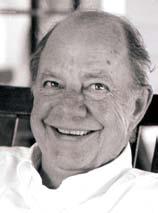
EMORY MEDICINE 26 alumni news Deaths
Peter Temple 63M
Hugh “Bill” Shackelford Jr. 60C 66M
Jean Staton 48G 53M 56FM
1970s
John Harrison 73M, of Atlanta, on March 2, 2012. He was 82. He is survived by his wife, Charlyne, three children, nine grandchildren, and a great-grandson.
Robert Almeroth 78M 79MR, of Avondale Estates, Ga., on Feb. 3, 2012, of prostate cancer. He was 73. He began as an information systems technician for IBM and Coca-Cola before applying to only one medical school, Emory, at age 35. He was a primary care physician at the Montreal Medical Center in Tucker and later, at DeKalb Medical Center.
1980s
Richard Stropp 81A 87M 88MR, of Juno Beach, Fla., on Jan. 29, 2012. He was 57. He practiced anesthesiology at St. Mary’s Hospital in West Palm Beach and later opened Interventional Pain Management of the Palm Beaches. He is survived by his wife, Ellen, seven children, and two grandsons.
Residency Deaths
Craig Cantrell medicine) of Gadsden, Ala., on March 11, 2012. He was 83. He is survived by his wife, Gloria, two children,

six grandchildren, and two great-grandchildren.
Harry Crider (obstetrics and gynecology), of Waleska, Ga., on Feb. 19, 2012. He was 93. He is survived by a son and two grandchildren.
Roy Crispin (general and cardiothoracic surgery) of Decatur, Ga., on Jan. 14, 2012, of pulmonary complications. He was 81. He spent the majority of his career at DeKalb Medical Center. He is survived by his wife, Diane, a son, daughter, and a granddaughter.

Donald Daniel (internal medicine), of Richmond, Va., on Feb. 5, 2012. He was 79. He is survived by his wife, Christa, and two children.
Louis FitzSimons (urology), of Tulsa, Okla., on Nov. 29, 2011. He is survived by his wife, Rachel, three children, and eight grandchildren.
William Helms (obstetrics and gynecology), of Atlanta, on March 17,

Albert Heyman (neurology), of Washington, on Feb. 10, 2012. He was 95. He joined the faculty of Duke University in 1954 and held an NIH Career Award from 1961 to 1990. His studies called attention to the relation of stroke to estrogenbased birth control pills and of the risk of stroke in African Americans. In 1979, he began researching Alzheimer’s. Duke recognized him with its Distinguished Teacher Award in 1991 and with the William Anlyan Lifetime Achievement Award in 2004. He was preceded in death by his wife and is survived by two daughters, six grandchildren, and six great-grandchildren.
Jerry Kelton (surgery), of Murfreesboro, Tenn., on Jan. 17, 2012. He was 42. He is survived by his daughter, parents, and a sister and brother.
Joseph Lesser (nephrology), of Atlanta, on March 13, 2012, from complications of Parkinson’s disease. He is
survived by his wife, Gayle, and a daughter.
Qahtan Malki (cardiology) of Lubbock, Texas, on March 4, 2010. He was 39. He is survived by his wife, Lama, and three children.
Leon Miller (rehabilitation medicine, dermatology, and radiology) of Las Vegas, on Jan. 20, 2012. He is survived by his wife, Judith, one son, and two grandsons.
Daniel Perling (internal medicine), of Marietta, Ga., on April 24, 2012, of lung cancer. He is survived by his wife, Peggy, two children, and two grandchildren.
Daniel Phillips (obstetrics and gynecology) of Spokane, Wash., on Jan. 3, 2012, of merkel cell carcinoma. He is survived by his wife, Bonnie, and four daughters.
Faculty Deaths
John Steinhaus (anesthesiology), of Make the rounds Medical Alumni Weekend
Save the Date
September 28-29, 2012
Don’t miss out on this great weekend!
FALL 2012 2727
Atlanta, on Feb. 17, 2012. He was founding chair of the Department of Anesthesiology and served as chair from July 1958 to 1983. He retired from practice in 1987. He was an author of a landmark study that led to the creation of anesthesia assistants.
At Emory, he created CPR training for medical students, developed a postgraduate course, Pharmacology for the Anesthesiologist, hired the first minority medical faculty member, and hired the first academic department business manager. He oversaw the training of more than 250 residents and established
the first master’s degree program in 1968 to train anesthesiologist physician assistants.
Says Carl Hug, professor of anesthesiology emeritus, “What he said was straightforward, without hidden agenda, and his handshake was more reliable than anything written on paper.” He is survived by his wife, Mila Jean, five children, nine grandchildren, three greatgrandchildren, and three great-great-grandchildren.
Elbert Tuttle (nephrology), of Atlanta, on March 18, 2012. He was 90 and was recently diagnosed with kidney cancer. He was on


VOLU NTEE R TO ASSIST
WITH
SERVGA is a statewide secure database of pre-credentialed healthcare professionals and other volunteers who want to help in case of a public health emergency.
SERVGA integrates governmentsponsored local, regional and statewide volunteer programs to assist emergency response and public safety organizations during a disaster.
the Emory medical faculty from 1956 until 1992, splitting his time between Grady and Crawford Long hospitals. He served as the first director of the Division of Renal Medicine and helped further development of
kidney dialysis. He was known as an enthusiastic and dedicated mentor. He was preceded in death by his wife, Ginny, and is survived by five children and four grandchildren.
GEORGIA’S DISASTER RECOVERY


Registering at www.servga.gov is quick and can be done within minutes. Name, address, contact information and occupation type completes the initial registration process. In order to be eligible, Responders are also encouraged to complete a Profile Summary.
To register for SERVGA, go online to: ww w.servga.gov. When you register, you will need to agree to the terms of service, and then will be asked to provide information specific to you and your skills. This information will be used to establish your emergency credentialing level and to contact you in the event of an emergency.
REGISTER TODAY . . . READY FOR TOMORROW
For additional information e-mail the SERVGA system coordinator at servga@dhr.state.ga.us


EMORY MEDICINE 28
faculty news Deaths
Elbert Tuttle
John Steinhaus
Cecile Jones
Gayle Thornton Kennedy
William King 38C 41M
Jim Scott first visited Emory as a senior medical student in 1985, attracted to Atlanta by martin Luther King Jr.’s legacy and Grady memorial Hospital’s reputation.

After meeting African American doctors in key positions at Emory, he knew he had found a place where a person could advance—borrowing from King’s words—“on the content of one’s character rather than the color of one’s skin.” He is now an Emory assistant professor of anesthesiology and a clinical anesthesiologist.
committed to promoting diversity, Scott mR90 has designated Emory as a beneficiary of his iRA to create the Hamilton Earl Holmes Scholarship.
Have a plan.
He made the gift both to honor the first African American medical student admitted to Emory School of medicine and to create opportunities for students to do great things. “Who knows when the next student is going to come along and change the world for us?” he says.
Learn more about how you can plan a legacy gift to Emory. Visit emory.edu/giftplanning or call 404.727.8875.
Plan to inspire greatness.
WINTER 2011 29
Emory University Alumni Records Office
1762 Clifton Road Atlanta, Georgia 30322
Emory is dedicated to sustaining the environment. After you’ve read this publication, please recycle or share it with a friend. Thank you.
Researchers and clinicians trying to bring a product to market find the challenging world of venture capital a little easier to navigate after taking a FastTrac course. 20
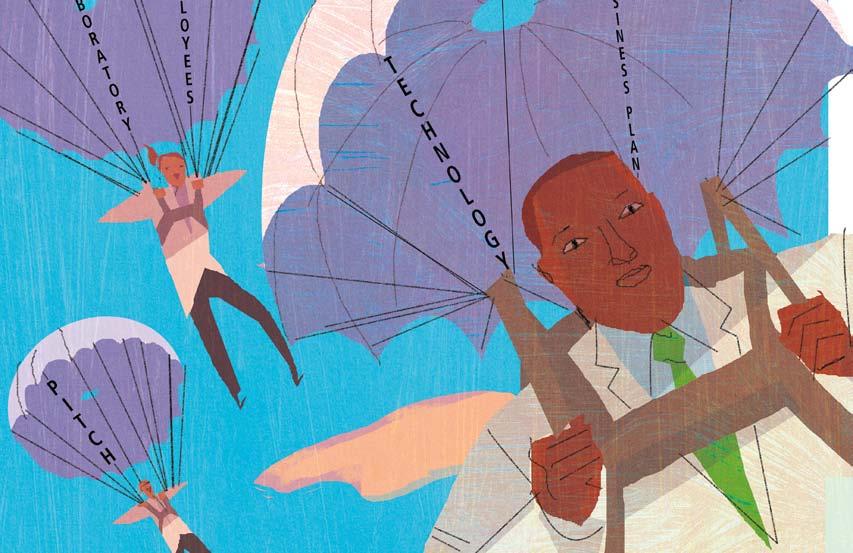
FALL 2012 31





















































 by Sylvia Wrobel
by Sylvia Wrobel






































